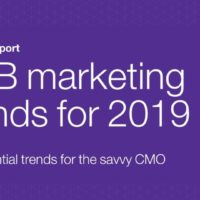
I was recently asked to participate in a virtual marketing event thanks to Chief Marketer where I delivered a presentation on building a content marketing program from scratch — with minimal resources and with practically no budget.
We all have challenges as content creators and marketers — small budgets, inability to demonstrate ROI, content not being used by marketing and sales thanks to corporate silos, the constant need to keep the content engine running, content that doesn’t seem to engage potential audiences, and more. I wish there was a magic wand to many of these problems, but I’ve often found the only solution was to roll up your sleeves and show up every day to chip away at them. Little by little you work to get better until you feel like you have a handle on most of these challenges.
The presentation I did for Chief Marketer leaned more on the practical side. My hope was to offer some guidance for how you can start to chip away at this challenges as a team of one or few. The approach seemed to resonate with the audience, so I figured I’d share.
Essentially, I walked through why content is an important aspect of marketing — especially in today’s environment when competing for people’s attention is harder than ever — but cautioned that it shouldn’t be a company/brand’s only marketing strategy. Content, when done well, is only one puzzle piece of the whole. It’s an important one to be sure, but it can’t be a strategy in and of itself.
So, how do you get started when you don’t know where or how to begin? There are five steps to consider for having a strategy and plan: discovery, ramp up, distribution, ideation or brainstorming, and measurement.
I’ll touch upon each of these five points more in-depth below. If you are browsing through the slides above I began the presentation with a nod to the Michelin Guide, which is one of my favorite antecedents for modern content marketers; and then I segue into a few slides on the challenges we all face in marketing today (everyone is in the content game, attention is hard to get, the traditional B2B funnel is broken, et al.).
I’ll skip over those points to focus on the five steps, which anyone should be able to follow to begin building an effective content marketing program. And to be sure, there is a lot I’m leaving out since this is just a shallow dive into the content marketing strategy pool.
Even if you work in a “boring” industry, though, keep in mind if there are stories and things about your product or service that you find interesting, chances are good that others in your industry — prospects or customers — will find them interesting too. That’s as good an anchor to hold onto as any.
Discovery
I had a lot of great ideas about the content I wanted to do when I started at Lord Hobo Brewing, but the first thing I did was sit down with sales and people in the company. I spoke with our distribution partners. I went out and met with our retail partners. Ultimately, a few threads began to emerge from those conversations: a total lack of communication from the brewery to partners and retail business, a need to show our best accounts more love, we had no database or CRM for tracking and nurturing our retail customers or prospects, on a macro level we simply needed to sell more beer, and our sales teams in states outside our home base of Massachusetts felt like they weren’t getting enough support from marketing.
We treat this like a direct mail campaign to accounts; each note contains a CTA to email the CEO if the account needs anything from us, sometimes we ask for direct feedback on how our beers are doing. We set up a dummy email account to include in the signature for our CEO that comes back to my inbox. So far we’ve seen about a 10-12% response rate on these.
What’s great, is I can then respond to any reply emails under the guise that our CEO asked me to follow-up, I can track those emails in our newly set-up Hubspot CRM via a Gmail plugin, and I can get them to opt-in to our monthly retail nurture newsletter (more on that in a moment), and basically establish a relationship with those accounts moving forward outside of individual sales members. Sales teams love it because they now feel supported in their territories by marketing, accounts feel gratitude for being recognized by our CEO for their hard work, and it helps me build a marketing list. This piece of content solves multiple problems for the company identified in discovery.
This is why you need to do discovery on an ongoing basis. It’s not enough to do it once, but it’s something you need to establish a regular rhythm for. But, take the time to get it right and it will pay huge dividends.
Ramp Up
With limited resources, you have to pick and choose what and how to prioritize. For me, that means starting with sales enablement and product-related content. I want to create content that is going to help close new deals. In many ways you could consider this starting at the bottom of the funnel and working your way back up top. Most marketers — and content marketers in particular — traditionally think in terms of the top of the funnel stretching toward the middle of it. But there’s a lot of value to add at the bottom of the funnel. Have you ever read an RFP from your sales team? Chances are good that you will earn a ton of professional goodwill by first prioritizing the content assets that are most valuable to sales teams winning deals — RFPs, client testimonials, product sheets, etc. Yes, with a little savvy you can even re-purpose most of this for your own ends for top of the funnel content.
Sales enablement content won’t be a lot of content, so you can knock a lot of it out and go back once a quarter or six months to update as needed.
After that, begin to tell all the great stories happening within the company, including ghost-written essays from subject matter experts. Show off what makes your company unique compared to the numerous competitors your are in a consideration set with. Decision-makers want to like, trust, and feel comfortable with a company they do business with. This is exactly what this type of content aims to achieve. Plus, you have immediate access to these resources, it helps create even more company buy-in with teams being featured, and often these are the stories that only your company can tell.
Then, branch out by doing some customer/prospect Q&As, create content that helps them do their job better or helps them work through specific problems (think of this as your infomercial content).
When you have momentum with these three strands of content you might start to dabble with tangentially-related content. You’ll probably still spend the bulk of time in the second and third buckets, but this kind of content helps establish beachheads of awareness with new market segments. Drift, a chatbot marketing company here in Boston, does this really well. They do a great job on marketing-related content, their core expertise, but have lately branched out into more general purpose business content. It feels like a natural extension of what they typically do and that’s a huge key.
Distribution
If you spend the time and effort to create content, then naturally you want people to read it. Distribution, then, is essentially the way you market your content marketing efforts. This encompasses four umbrellas: owned, paid, earned, and shared.
(image: Spin Sucks)
Owned are all the places you have control over: your blog, newsletter, your social channels, app notifications. Paid is anywhere you put your content with money behind it to garner more eyeballs: sponsored social posts, online ads, Taboola or Outbrain, Reddit. Earned is when other publications pick up your content and link to it. Shared is when other people spread your content via their social networks.
You can leverage all four of these approaches if you have a dedicated social team, a PR team, demand gen, and plenty of money for paid media. Most SMBs don’t have these resources. And most older, larger enterprise businesses haven’t shifted tactics quickly enough to take advantage. They’re still running the same old playbook.
For me, because of the current limitations, I’m focused on two distribution strategies at the moment: owned, specifically a monthly newsletter, and social. Eventually, I’ll fold in some earned strategies if I can. But for now, my goal is to leverage what I can. Don’t overlook your own social channels and the the social networks of your company employees. At the brewery we have 70 or so employees. Everyone in your company should and can be an extension of your marketing efforts. An article I wrote about the best beer podcasts I put on my own LinkedIn network picked up about a 1000 views just from that alone! So even if you are a one person shop, don’t overlook your own social and those of the people in your company for pushing content. It requires a bit of internal marketing effort but it’s worth it.
Ultimately, you need to be thinking about content + distribution, whatever that distribution might be. Think about how a single piece of content can be chopped up, remixed, and reused across Facebook, Instagram, LinkedIn, pushed to places like Reddit or Fark, sent to industry bloggers or writers as something they might want to push on your behalf, given to sales to send in emails, etc.
Ideation
As far as finding things to write about, if you are curious and tune your antennae a bit you’ll realize there’s no shortage of places to get ideas from. I won’t dwell too long on this. Typically, idea generators can be lumped into a few buckets: internal, external, and digital.
Internal generators include sales, SMEs, or your customers, for example. External generators include trade publications, analyst reports, your competitors, original data, surveys, social media, etc. Digital generators include a handful of awesome tools (free with paid tiers) like BuzzSumo, Ubersuggest, SEMrush, Google Trends, or Answer the Public. These tools are like your content marketing cheat code.
Further, I would encourage everyone to set up a Swipe File if you don’t have one. This is an old concept in advertising, but easy to create digitally via apps or browser bookmarks. The swipe file is the place I save everything related to content, advertising, and marketing – stuff I love whether it’s videos, landing pages, articles, whatever, because you never know when you might want to take something and make it your own.
In fact, the hand-written note campaign came from my swipe file after a marketer showed it to me a few years ago. I stashed it away, mostly forgot about it, and years later at LHBCo. a light bulb went off after doing discovery. So, set up a swipe file and make it an essential part of your marketing toolbox.
Measurement
I’m hyper aware that we can all measure ourselves to death. There’s like 90 million things you could measure across numerous marketing disciplines to prove your ROI to the company. When you are tasked with consistently proving your worth as a marketer, it’s easy to cherry pick certain metrics to make yourself look better.
Every business situation will be unique and just because someone says you should be measuring something doesn’t necessarily mean you should be. Wherever you put your flag in the ground, you want it tied almost directly back to your business goal and the reason for why you are doing content in the first place. Honestly, you might have a few different things your measuring for different strategies, but I would advise to keep it simple and focus on no more than a handful of things, otherwise you’ll just drown yourself in a sea of meaningless metrics.
For example, if you need to grow your sales pipeline, then you may chose to focus on driving qualified leads. If you don’t need leads because you have an account-based strategy then you might measure something else. Realistically, you’ll likely have a few things you’re measuring at once and within that you’ll be looking at analytics to help you figure out the levers you need to pull to accomplish your goals.
I’m focused almost entirely on measuring my success via the number of people receiving our retail newsletter. My initial hypothesis is if I can 10x that retail email list that was at zero when I started, that will ultimately help us sell more beer (the desired business outcome). But, my goals and metrics might change over time and I need to be fluid enough to adapt when the time comes.
Conclusion
Holy shit, this ended up being way longer than I intended it to be and way longer than people have the patience to read. I hope it was useful at a high-level.
About Guest Contributor: James Furbush is a freelance content marketer helping brands tell their stories. Contact him at jamesfurbush.com










